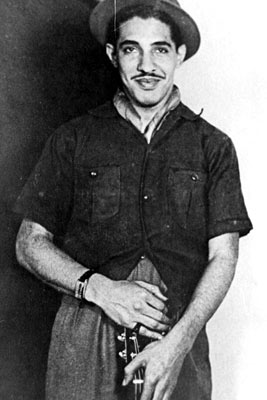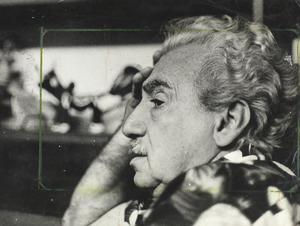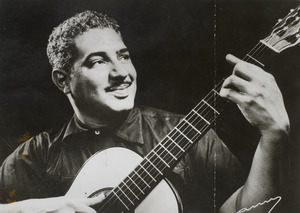Dorival Caymmi facts for kids
Quick facts for kids
Dorival Caymmi
|
|
|---|---|

Caymmi in 1938
|
|
| Background information | |
| Birth name | Dorival Caymmi |
| Born | April 30, 1914 Salvador, Bahia, Brazil |
| Origin | Salvador, Bahia, Brazil |
| Died | August 16, 2008 (aged 94) Copacabana, Rio de Janeiro, Brazil |
| Genres | Samba, bossa nova |
| Occupation(s) | Singer, songwriter |
| Instruments | Vocals, guitar |
| Years active | 1933–2008 |
| Labels | Odeon Columbia Continental RCA Victor Elenco Phonogram Funarte Som Livre Universal EMI |
| Associated acts | Tom Jobim João Gilberto Nana Caymmi Dori Caymmi Danilo Caymmi |
Dorival Caymmi (April 30, 1914 – August 16, 2008) was a famous Brazilian singer, songwriter, actor, and painter. He was active for over 70 years, starting in 1933.
He helped create Brazil's bossa nova music style. Many of his samba songs, like "Samba da Minha Terra" and "Doralice", are now Brazilian classics. He also wrote beautiful songs about the fishermen and women of Bahia, such as "Promessa de Pescador". Caymmi wrote about 100 songs in his life. Many musicians, both Brazilian and from other countries, have sung his songs.
A writer from The New York Times said Caymmi was very important for Brazilian music. His songs about the people and culture of Bahia shaped how Brazil was seen by others. Caymmi was married to singer Stella Maris for 68 years. Their children, Dori, Danilo, and Nana, are also well-known musicians. They all started their careers by performing with their father. In 2014, his granddaughter Alice also became a musician.
Contents
Early Life and First Songs
Caymmi was born in Salvador, Bahia, a city in Brazil. His father played music at home, and his mother sang often. Dorival sang in his church's choir when he was young.
At 13, he started working as a journalist for a newspaper. When the newspaper closed, he became a street vendor. Even though he didn't formally study music, he taught himself guitar in the late 1920s. He began writing and singing his own songs on Bahian radio shows around 1930.
He became widely known in 1933. He wrote the song "O Que É Que a Baiana Tem?" for singer Carmen Miranda. In 1936, he won a songwriting contest at Salvador's annual Carnaval. He moved to Rio de Janeiro in 1938. He planned to study law and work as a journalist again. While working at a newspaper, he spent his free time writing and singing on a radio show. His music became very popular with the show's listeners.
Caymmi's Music Career
His Unique Style
Many of Caymmi's songs celebrate the life, beaches, fishermen, and women of his home state, Bahia. He got a lot of ideas from music from northeastern Brazil. This included Afro-Brazilian music and samba.
He recorded music for over 50 years and released about 20 albums. Sometimes he sang alone with his guitar. Other times, bands and orchestras played with him. Even though he wrote only about 100 songs, they were known for being very high quality. He sometimes worked with Tom Jobim, who called him a "universal genius." Many modern Brazilian artists say Caymmi greatly influenced their music.
Key Moments in His Career
"O Que É Que a Baiana Tem?" became even more famous in Brazil. This was after Carmen Miranda sang it in the 1939 movie Banana da Terra. This song helped her become famous around the world. After this success, Caymmi focused more on music. He wrote songs for other Brazilian films.
In 1939, he signed with Odeon Records. He recorded his first three songs, including "Rainha do Mar" and "O Que É Que a Baiana Tem?". He became more famous in the early 1940s. He performed regularly on the Brazilian radio network Rádio Nacional. He recorded "Samba da Minha Terra" in 1940. In 1944, he sang his own song "Acontece Que Eu Sou Baiano" in a movie. In the late 1940s, he was part of the samba-canção music movement. Other famous Brazilian musicians covered his songs, like Dick Farney who sang "Marina" in 1947.
In the 1950s and 1960s, musicians like Tom Jobim and João Gilberto worked with Caymmi. They helped create the bossa nova style. Gilberto sang many of Caymmi's songs, like "Rosa Morena". Jobim loved Caymmi's music, and they became close friends. In 1965, an American writer translated Caymmi's song "Das Rosas" into English. It was released as "...and Roses and Roses". Singers like Astrud Gilberto and Andy Williams recorded it. Williams's version was a hit. Because of this, Caymmi was invited to Los Angeles. He performed, filmed a TV show, and recorded an album there.
Working with Jorge Amado

Caymmi was a lifelong friend of the Bahian writer Jorge Amado. In 1945, Caymmi put one of Amado's poems to music. This was to help a political campaign. Later, in the 1970s, Caymmi was inspired by Amado again. He wrote "Modinha para a Gabriela", a song based on Amado's book Gabriela, Cravo e Canela.
Perhaps their most famous song together is "É Doce Morrer no Mar" ("It's Sweet to Die in the Sea"). They wrote it one night over dinner at Amado's house. Other songs they wrote together include "Beijos pela Noite" and "Essa Nega Fulô".
Awards and Special Recognitions
In 1968, the governor of Bahia gave Caymmi a house in Salvador. This was to thank him for making Brazilian music famous worldwide. He lived in his hometown for a short time. In 1972, Caymmi received the Order of Merit of the State of Bahia. This award is for people who do great service for the state. Caymmi received it for bringing pride to Bahian people through his music.
On Caymmi's 70th birthday in 1984, the French Minister of Culture gave him an award in Paris. It was the Ordre des Arts et des Lettres, which honors people who contribute to art and literature. The next year, a new street in Salvador was named Avenida Dorival Caymmi. In 1986, Rio de Janeiro's famous Mangueira samba school based its Carnaval performance on Caymmi's life. The school won the annual samba competition that year. In 2015, an album honoring him was nominated for a Latin Grammy Award.
His Life Outside Music
Even though Caymmi was famous for music, he also painted. From 1943 to 1945, he took drawing and painting classes in Rio de Janeiro. He continued to paint for the rest of his life.
He also practiced Candomblé, an Afro-Brazilian religion. This religion involves belief in spirit-gods and special ceremonies. It was his father's religion. Caymmi became more involved in it as an adult when friends invited him to ceremonies.
Family Life
In 1939, he met singer Adelaide Tostes, known as Stella Maris, at Rádio Nacional. They married in 1940 and stayed together for 68 years until his death. They had three children: Nana, Dori, and Danilo. All three became musicians, following in their father's footsteps.
His Views on Society
Caymmi usually didn't put political messages in his songs. However, he often spoke about problems with the government. His close friend Jorge Amado had to leave Brazil for several years. This was because he spoke out against the military government at the time. In 1994, Caymmi said that being a citizen in Brazil felt like a joke.
His Passing
Dorival Caymmi passed away at age 94 on August 16, 2008. He died at his home in Copacabana, Rio de Janeiro. His granddaughter, Stella, who wrote a book about him, said he didn't know he had cancer. He didn't want to know about his illness. He faced each day calmly, and his family respected his wish.
Discography
Albums
Before 1988, all of Caymmi's albums were released as LP records. His last four albums were released as CDs.
| Year | Title | English translation | Label | Ref |
|---|---|---|---|---|
| 1954 | Canções Praieiras | Beach Songs | Odeon | |
| 1955 | Sambas | Sambas | Odeon | |
| 1957 | Eu Vou pra Maracangalha | I'm Going to Maracangalha | Odeon | |
| Caymmi e o Mar | Caymmi and the Sea | Odeon | ||
| 1958 | Ary Caymmi e Dorival Barroso | Ary Caymmi and Dorival Barroso | Odeon | |
| 1959 | Caymmi e Seu Violão | Caymmi and His Guitar | Odeon | |
| 1960 | Eu Não Tenho Onde Morar | I've Got Nowhere to Live | Odeon | |
| 1964 | Caymmi Visita Tom | Caymmi Visits Tom | Elenco | |
| 1965 | Caymmi | Caymmi | Odeon | |
| 1967 | Vinicius e Caymmi no Zum Zum | Vinicius and Caymmi at Zum Zum | Elenco | |
| 1972 | Caymmi | Caymmi | Odeon | |
| 1973 | Caymmi Também É de Rancho | Caymmi Is Also from the Ranch | Odeon | |
| 1984 | Setenta Anos | Seventy Years | Funarte | |
| 1985 | Caymmi, Som, Imagem e Magia | Caymmi, Sound, Image and Magic | Sargaço Produções | |
| 1987 | Família Caymmi | The Caymmi Family | ||
| 1988 | Família Caymmi em Montreux | The Caymmi Family in Montreux | Odeon | |
| 1994 | Caymmi em Família | Caymmi as a Family | Som Livre | |
| 1996 | Caymmi Inédito | Unedited Caymmi | Universal | |
| 2000 | Caymmi: Amor e Mar | Caymmi: Love and the Sea | EMI |
Singles
All of Caymmi's singles were released as 78 rpm gramophone records.
| Year | Title | English translation | Label | Ref |
|---|---|---|---|---|
| 1939 | "Rainha do Mar"/"Promessa de Pescador" | "Queen of the Sea"/"Promise of the Fisherman" | Odeon | |
| "Roda Pião" | "Spinning Wheel" | Odeon | ||
| "O Que É Que a Baiana Tem?"/"A Preta do Acarajé" | "What Is It About Bahian Women?"/"The Dark Lady of Acarajé" | Odeon | ||
| 1940 | "O Mar (I)"/"O Mar (II)" | "The Sea (I)"/"The Sea (II)" | Columbia | |
| "Navio Negreiro"/"Noite de Temporal" | "Slave Ship"/"Stormy Night" | Odeon | ||
| 1941 | "É Doce Morrer no Mar"/"A Jangada Voltou Só" | "It's Sweet to Die in the Sea"/"The Raft Returned Alone" | Columbia | |
| "Essa Nega Fulô"/"Balaío Grande" | "This Feisty Dark Lady"/"Great Hamper" | Columbia | ||
| 1943 | "O Mar (I)"/"O Mar (II)" | "The Sea (I)"/"The Sea (II)" | Continental | |
| "É Doce Morrer no Mar"/"A Jangada Voltou Só" | "It's Sweet to Die in the Sea"/"The Raft Returned Alone" | Continental | ||
| "Essa Nega Fulô"/"Balaío Grande" | "This Feisty Dark Lady"/"Great Hamper" | Continental | ||
| 1945 | "Dora"/"Peguei Um Ita no Norte" | "Dora"/"I Caught a Steamboat in the North" | Odeon | |
| 1946 | "A Vizinha do Lado"/"Trezentos e Sessenta e Cinco Igrejas" | "The Girl Next Door"/"Three Hundred and Sixty-five Churches" | Odeon | |
| 1947 | "Marina"/"Lá Vem a Baiana" | "Marina"/"Here Comes the Bahian Girl" | RCA Victor | |
| 1948 | "Cantiga"/"Sodade Matadera" | "Folk Song"/"Agonizing Longing" | RCA Victor | |
| "A Lenda do Abaeté"/"Saudades de Itapoã" | "The Legend of Abaeté"/"Missing Itapoã" | RCA Victor | ||
| 1949 | "O Vento"/"Festa de Rua" | "The Wind"/"Block Party" | RCA Victor | |
| 1952 | "Não Tem Solução"/"Nem Eu" | "There Is No Solution"/"Me Neither" | Odeon | |
| 1953 | "Tão Só"/"João Valentão" | "So Alone"/"Tough John" | Odeon | |
| 1954 | "A Jangada Voltou Só"/"É Doce Morrer no Mar" | "The Raft Returned Alone"/"It's Sweet to Die in the Sea" | Odeon | |
| "Quem Vem pra Beira do Mar"/"Pescaria (Canoeiro)" | "Who's Coming to the Seaside"/"Fishing (in a Canoe)" | Odeon | ||
| 1956 | "Maracangalha"/"Fiz uma Viagem" | "Maracangalha"/"I Took a Journey" | Odeon | |
| "Saudades de Itapoã"/"A Lenda do Abaeté" | "Missing Itapoã"/"The Legend of Abaeté" | Odeon | ||
| "Sábado em Copacabana"/"Só Louco" | "Saturday in Copacabana"/"Just Crazy" | Odeon | ||
| 1957 | "2 de Fevereiro"/"Saudades de Itapoã" | "The Second of February"/"Missing Itapoã" | Odeon | |
| "Acalanto"/"História pro Sinhozinho" | "Lullaby"/"A Story for the Little Man" | Odeon | ||
| "Saudade da Bahia"/"Roda Pião" | "Missing Bahia"/"Spinning Wheel" | Odeon | ||
| 1960 | "Rosa Morena"/"Acalanto" | "Dark Rose"/"Lullaby" | Odeon | |
| "São Salvador"/"Eu Não Tenho Onde Morar" | "São Salvador"/"I've Got Nowhere to Live" | Odeon |
Tributes
| Year | Artist | Title | English translation | Label | Ref(s) |
|---|---|---|---|---|---|
| 1976 | Gal Costa | Gal Canta Caymmi | Gal Sings Caymmi | Phonogram | |
| 2002 | Olivia Hime | Mar de Algodão: As Marinhas de Caymmi | Sea of Cotton: The Seascapes of Caymmi | Biscoito Fino | |
| 2004 | Various | Caymmi: 90 Anos – Mar e Terra | Caymmi: 90 Years – Sea and Land | BMG |
See also
 In Spanish: Dorival Caymmi para niños
In Spanish: Dorival Caymmi para niños


